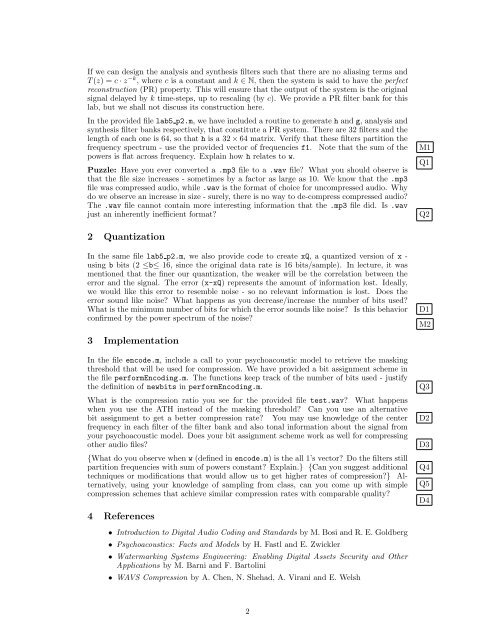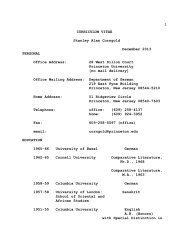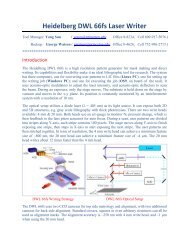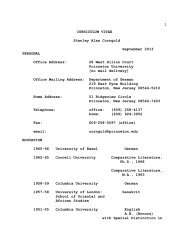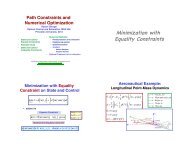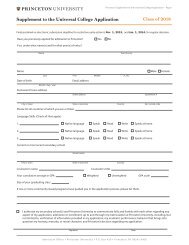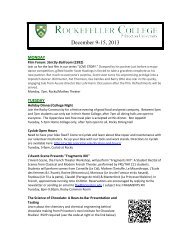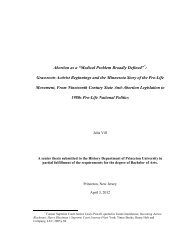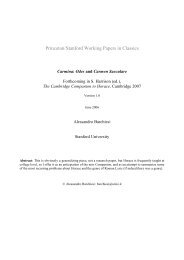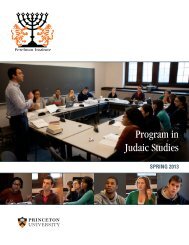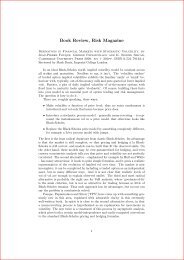ELE 201, Spring 2013 Laboratory No. 5 Part 2 Audio Compression ...
ELE 201, Spring 2013 Laboratory No. 5 Part 2 Audio Compression ...
ELE 201, Spring 2013 Laboratory No. 5 Part 2 Audio Compression ...
Create successful ePaper yourself
Turn your PDF publications into a flip-book with our unique Google optimized e-Paper software.
If we can design the analysis and synthesis filters such that there are no aliasing terms and<br />
T (z) = c · z −k , where c is a constant and k ∈ N, then the system is said to have the perfect<br />
reconstruction (PR) property. This will ensure that the output of the system is the original<br />
signal delayed by k time-steps, up to rescaling (by c). We provide a PR filter bank for this<br />
lab, but we shall not discuss its construction here.<br />
In the provided file lab5 p2.m, we have included a routine to generate h and g, analysis and<br />
synthesis filter banks respectively, that constitute a PR system. There are 32 filters and the<br />
length of each one is 64, so that h is a 32 × 64 matrix. Verify that these filters partition the<br />
frequency spectrum - use the provided vector of frequencies f1. <strong>No</strong>te that the sum of the M1<br />
powers is flat across frequency. Explain how h relates to w.<br />
Q1<br />
Puzzle: Have you ever converted a .mp3 file to a .wav file? What you should observe is<br />
that the file size increases - sometimes by a factor as large as 10. We know that the .mp3<br />
file was compressed audio, while .wav is the format of choice for uncompressed audio. Why<br />
do we observe an increase in size - surely, there is no way to de-compress compressed audio?<br />
The .wav file cannot contain more interesting information that the .mp3 file did. Is .wav<br />
just an inherently inefficient format?<br />
Q2<br />
2 Quantization<br />
In the same file lab5 p2.m, we also provide code to create xQ, a quantized version of x -<br />
using b bits (2 ≤b≤ 16, since the original data rate is 16 bits/sample). In lecture, it was<br />
mentioned that the finer our quantization, the weaker will be the correlation between the<br />
error and the signal. The error (x-xQ) represents the amount of information lost. Ideally,<br />
we would like this error to resemble noise - so no relevant information is lost. Does the<br />
error sound like noise? What happens as you decrease/increase the number of bits used?<br />
What is the minimum number of bits for which the error sounds like noise? Is this behavior<br />
confirmed by the power spectrum of the noise?<br />
3 Implementation<br />
D1<br />
M2<br />
In the file encode.m, include a call to your psychoacoustic model to retrieve the masking<br />
threshold that will be used for compression. We have provided a bit assignment scheme in<br />
the file performEncoding.m. The functions keep track of the number of bits used - justify<br />
the definition of newbits in performEncoding.m.<br />
What is the compression ratio you see for the provided file test.wav? What happens<br />
when you use the ATH instead of the masking threshold? Can you use an alternative<br />
bit assignment to get a better compression rate? You may use knowledge of the center D2<br />
frequency in each filter of the filter bank and also tonal information about the signal from<br />
your psychoacoustic model. Does your bit assignment scheme work as well for compressing<br />
other audio files?<br />
D3<br />
{What do you observe when w (defined in encode.m) is the all 1’s vector? Do the filters still<br />
partition frequencies with sum of powers constant? Explain.} {Can you suggest additional<br />
techniques or modifications that would allow us to get higher rates of compression?} Alternatively,<br />
using your knowledge of sampling from class, can you come up with simple<br />
compression schemes that achieve similar compression rates with comparable quality?<br />
4 References<br />
• Introduction to Digital <strong>Audio</strong> Coding and Standards by M. Bosi and R. E. Goldberg<br />
• Psychoacoustics: Facts and Models by H. Fastl and E. Zwickler<br />
• Watermarking Systems Engineering: Enabling Digital Assets Security and Other<br />
Applications by M. Barni and F. Bartolini<br />
• WAVS <strong>Compression</strong> by A. Chen, N. Shehad, A. Virani and E. Welsh<br />
Q3<br />
Q4<br />
Q5<br />
D4<br />
2


